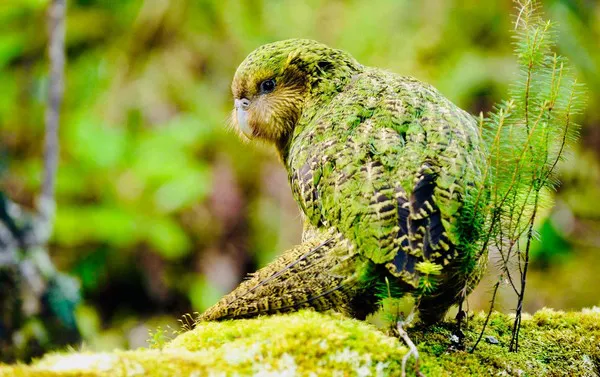In the vast and diverse tapestry of the animal kingdom, there are species that exhibit behaviors that might appear strange or nonsensical to human observers. From peculiar mating rituals to seemingly irrational decision-making, these animals challenge our understanding and offer glimpses into the fascinating complexity of life on Earth. In this article, we delve into the quirks and idiosyncrasies of eight animals with behaviors that some might perceive as “stupid” or nonsensical.
8 Animals With Unusual Behaviors
1. Kakapo (Strigops habroptilus)
The kakapo, also known as the “owl parrot,” is a flightless, nocturnal bird native to New Zealand. While the kakapo’s behavior might not be classified as “stupid” in the traditional sense, its evolutionary adaptations and interactions with humans have led to a precarious existence for this unique species.
One of the most peculiar aspects of kakapo behavior is its lack of fear of predators, which contributed to its vulnerability to introduced mammalian predators, such as rats, cats, and stoats. Additionally, the kakapo’s mating ritual, characterized by booming calls and synchronized displays, is not only elaborate but also ineffective due to the bird’s low reproductive rate and habitat fragmentation.
Despite conservation efforts aimed at saving the kakapo from extinction, including intensive predator control and captive breeding programs, the species remains critically endangered. The kakapo serves as a poignant reminder of the profound impact of human activities on fragile ecosystems and the importance of proactive conservation measures.
2. Sloth (Bradypus spp. and Choloepus spp.)
Sloths, renowned for their sluggish movements and relaxed demeanor, are often perceived as “stupid” due to their seemingly lethargic behavior. However, the sloth’s unique adaptations to its arboreal lifestyle offer insights into the evolutionary trade-offs between energy conservation and survival in its rainforest habitat.
Sloths possess a remarkably slow metabolism and spend the majority of their time resting or sleeping, conserving energy to digest their fibrous, low-nutrient diet of leaves. While their leisurely pace might seem inefficient, it helps minimize energy expenditure and reduces the risk of predation by blending into their surroundings.
Furthermore, sloths exhibit a curious behavior known as algae farming, wherein green algae grow symbiotically in their fur, providing camouflage and additional nutrients. Although this behavior might appear “stupid” to human observers, it illustrates the sloth’s resourcefulness in utilizing its environment to meet its needs.
3. Turkey (Meleagris gallopavo)
The domestic turkey, often associated with Thanksgiving feasts and holiday traditions, has a reputation for displaying behaviors that some might consider unintelligent or comical. From their distinctive gobbling calls to elaborate courtship displays, turkeys exhibit a range of behaviors shaped by their social structure and breeding biology.
One of the most notorious turkey behaviors is “circling,” wherein male turkeys, known as toms, engage in repetitive, circular movements around a perceived threat or object of interest. While this behavior might seem amusing to humans, it serves as a territorial display and a means of asserting dominance within the flock.
Additionally, male turkeys display extravagant courtship rituals, including strutting, puffing out their feathers, and vocalizing to attract mates. Despite the seemingly frivolous nature of these behaviors, they play a crucial role in mate selection and reproductive success within turkey populations.
4. Panda Ant (Euspinolia militaris)
The panda ant, despite its name, is not actually an ant but rather a species of wingless wasp found in South America. Known for its striking black-and-white coloration reminiscent of a giant panda, the panda ant exhibits behaviors that might be perceived as “stupid” due to its aggressive nature and peculiar reproductive strategy.
Female panda ants, armed with a potent sting, are solitary hunters that prey on other insects, including bees and wasps. However, their reproductive strategy is where things take a bizarre turn: male panda ants lack wings and are incapable of flight, relying on clumsy walking to locate mates.
Furthermore, male panda ants are often mistaken for ants due to their resemblance in appearance, leading to confusion and potential danger for unsuspecting predators. Despite their seemingly awkward behavior, panda ants play a role in their ecosystems as predators and serve as a reminder of the diversity of life on Earth.
5. Dumbo Octopus (Grimpoteuthis spp.)
The dumbo octopus, named for its resemblance to the Disney character Dumbo the elephant, is a deep-sea dweller with distinctive ear-like fins and a gelatinous body. While its appearance might evoke curiosity and wonder, the dumbo octopus’s behavior is characterized by its peculiar locomotion and reproductive strategy.
Unlike other octopus species known for their jet propulsion and camouflage abilities, the dumbo octopus relies on its ear-like fins to gracefully glide through the depths of the ocean. This unique form of locomotion, combined with its soft body and elongated arms, allows the dumbo octopus to navigate its environment with ease.
Furthermore, the reproductive behavior of the dumbo octopus is shrouded in mystery, as few observations have been made in its deep-sea habitat. However, researchers speculate that dumbo octopuses engage in elaborate courtship displays and mating rituals, relying on chemical cues and tactile communication to locate potential mates in the vast expanse of the ocean.
6. Glaucus Atlanticus (Glaucus atlanticus)
The Glaucus atlanticus, also known as the blue dragon or sea swallow, is a species of small, strikingly colored sea slug found in tropical and temperate waters worldwide. Despite its diminutive size, the Glaucus atlanticus exhibits behaviors that are both fascinating and unconventional, earning it a place among the world’s “stupidest” animals.
One of the most remarkable aspects of Glaucus atlanticus behavior is its feeding strategy, which involves preying on venomous cnidarians, such as the Portuguese man o’ war. Rather than avoiding contact with these dangerous organisms, the Glaucus atlanticus actively seeks them out, ingesting their venomous tentacles and incorporating their toxins for its own defense.
Additionally, the Glaucus atlanticus employs a unique form of camouflage known as countershading, wherein its vivid blue coloration blends seamlessly with the sunlit surface of the ocean when viewed from below. This adaptive coloration not only helps conceal the Glaucus atlanticus from predators but also enhances its predatory efficiency as it drifts along ocean currents in search of prey.
7. Kakapo (Strigops habroptilus)
The kakapo, also known as the “owl parrot,” makes a second appearance on this list due to its unique combination of evolutionary quirks and interactions with humans. While the kakapo’s behavior might not fit the traditional definition of “stupid,” its vulnerability to introduced predators and limited reproductive success have led to a precarious existence for this endangered species.
One of the most remarkable aspects of kakapo behavior is its reliance on auditory communication, including booming calls and infrasound, to navigate its forest habitat and locate potential mates. While effective in the absence of natural predators, this communication strategy has become a liability in the face of introduced mammalian predators, which can locate kakapos by their calls.
Furthermore, the kakapo’s reproductive behavior, characterized by irregular breeding cycles and low fertility rates, presents challenges for conservation efforts aimed at boosting population numbers. Despite intensive predator control and captive breeding programs, the kakapo remains critically endangered, highlighting the need for ongoing conservation efforts to safeguard its future.
8. Proboscis Monkey (Nasalis larvatus)
The proboscis monkey, native to the mangrove forests and riverine habitats of Borneo, is known for its distinctive appearance, including a bulbous nose and potbelly. While its physical features might evoke amusement or curiosity, the proboscis monkey’s behavior is equally intriguing, characterized by its social dynamics and unusual vocalizations.
One of the most prominent aspects of proboscis monkey behavior is its social structure, which revolves around complex hierarchical relationships within multi-male, multi-female groups. Male proboscis monkeys compete for dominance through vocalizations, displays, and physical confrontations, with alpha males enjoying privileged access to resources and mating opportunities.
Additionally, the proboscis monkey’s vocalizations, including honks, grunts, and calls, play a crucial role in communication within the group and maintaining social cohesion. These vocalizations serve various functions, including signaling alarm, establishing territory boundaries, and coordinating group movements in response to threats or opportunities.
See Also: Scientists Rank The 12 Best Animals For Pets
Conclusion
In conclusion, the animal kingdom is replete with species that exhibit behaviors that might appear “stupid” or nonsensical to human observers. However, upon closer examination, these behaviors often reveal remarkable adaptations to specific ecological niches and evolutionary trade-offs that have shaped the diversity of life on Earth. By embracing the quirks and idiosyncrasies of nature, we can gain a deeper appreciation for the complexity and beauty of the natural world.
You Might Be Interested In:























